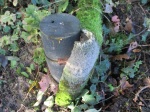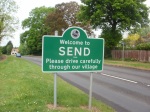Hello, Mrs Hg137 here.
Finally the sun came out. But it had rained on each of the last 13 days – a total of 78.6 mm or 3 inches – and everywhere was waterlogged. Where could we go, and have a chance of staying mainly dry? We chose Ockwells Park which lies to the west of Maidenhead, just north of the M4 and just west of the A404M. Some of the park was once part of the Ockwells Manor Estate, and the manor house can be seen to the west of the park. The park opened to the public in the 1980s and now includes a café, a large play area and sports pitches for softball and baseball. And for us, our research also showed that it had well-maintained tracks and paths, a large free car park, and lots of parkland / woodland / nature reserve where a set of geocaches could be found.
Our first geocache the Ockwells Park Mystery geocache, lay just outside the park. We’d done the vaguely literary puzzle beforehand and we duly found the cache. But oh dear, the log was really wet. Mr Hg137 suggested drying the wet log in the warm geocar, and we would replace it later. We left a small piece of paper in the cache as a temporary log.
Back in the park, we set off on our geocaching route. We started off near the café and play area, then walked further on into the wilder area which is a nature reserve. After walking along firm tracks, we ventured into waterlogged fields and then onto a puddly track which led close to Ockwells Manor. The original Manor House was built in the 15th century using wood from oak trees grown in Windsor Forest, which at the time stretched as far as the park; it was offered to the National Trust in the 1940s, but they turned it down. Walking up the track, we paused to look at the manor, in the middle distance past a field with grazing horses. And a tank. A full-size military tank. “What about the tank?” I asked Mr Hg137. “What tank … oooh!” he replied. He hadn’t spotted it!


We left the incongruous metal object behind us, and moved on. We were doing well, but we had slight worries about the next geocache, Hang tough! One of us is old enough to remember watching (the original) ‘Gladiators’ on TV and was nervous that something like the ‘Hang Tough’ round in that game would be needed. Fortunately no dangling from anything needed for us today! Our walking pole was enough to lift down and replace the cache – no swinging in trees needed.
We made a brief foray south, over the M4, to look for more caches along a footpath between some very posh houses. One was in a fake birdbox – well, we weren’t absolutely certain it was fake, so opened it very, very carefully – but no bird had ever used this (phew). Then back across the motorway, and into Little Thrift Wood at the southern end of the park, where our route led us along a path just a fence away from the motorway (and actually not very noisy). After looking for two more caches we walked back into the park area.
It was wetter at this end of the park, and had probably been underwater only a day or two before. We ended the walk with dry feet, but muddy trousers, having explored a little area of parkland and open country that we’d never even heard of before, let alone planned to visit. And what of the soggy geocache log from the start of the day? It had spent the day in the sunshine inside the car, and was dry when we returned. We revisited the cache and replaced the official log, now dry (and no-one had signed our temporary log while we were away!).
Here is just one of the caches we found:


































































































